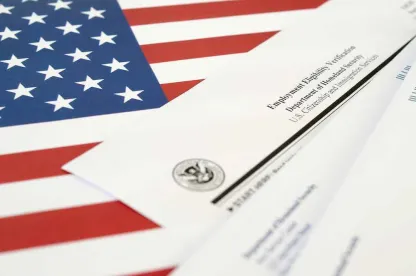The Department of Homeland Security (DHS) recently extended its Form I-9 temporary flexibility procedures for deferring physical inspection of documents. DHS first implemented these flexibility procedures at the start of the pandemic and has granted multiple, brief extensions. Under DHS’s most recent extension, the flexibility procedures will be in effect through December 31, 2021. DHS also expanded the circumstances in which employers may rely on these procedures to complete the Form I-9, Employment Eligibility Verification.
Brief Recap: I-9 Temporary Flexibility Procedures
As we explained in more detail in a prior post, in March 2020 DHS issued the I-9 temporary flexibility procedures as employers moved to remote operations because of the pandemic. The regular Form I-9 procedures require the employer to meet in person with the new hire or existing employee (for reverification). During this in-person meeting, the employer physically inspects the documents presented by the employee to show identity and employment authorization (new hire) or employment authorization (reverification). The employer must inspect these documents within three business days of hire or, in the case of reverification, by the date on which the prior evidence of employment authorization expires. Employers with remote operations are unable to complete the required physical document inspection.
Under the flexibility procedures, qualifying employers may conduct a virtual review of the I-9 documents and temporarily defer the physical inspection of those documents. When conducting the virtual inspection, the employer must confirm the nature of the inspection in the “Additional Information” field in § 2 of Form I-9. For example:
COVID-19: Remote inspection completed on mm/dd/yyyy
Employers then must complete the physical document inspection within three business days after (1) returning to “normal operations” or (2) DHS’s termination of the temporary flexibility procedures, whichever occurs earlier. When the employer completes the in-person physical inspection of the I-9 documents, the employer also should confirm in the Additional Information field. For example:
COVID-19: Documents physically examined on mm/dd/yyyy. [Enter initials if the same person who completed the virtual document inspection also completes the physical document review; if a different person reviews the documents, state the new person’s full name and job title]
Employers that use electronic I-9 software may have difficulty making the required entries in the “Additional Information” field. Such employers may use a paper Form I-9 to complete the Additional Information entries. Those employers should produce the electronic Form I-9 and the associated paper Form I-9 during a government I-9 inspection.
Extensions and Updates: I-9 Temporary Flexibility Procedures
The flexibility procedures were initially implemented for 60 days and available only to those employers that were operating exclusively in a remote setting. Employers that engaged in both remote and onsite operations were not eligible. This was true even if the employer’s hybrid operations consisted of only a few essential staff onsite while all other employees worked remotely. Although DHS has extended the flexibility procedures in short increments multiple times, it has been reluctant to broaden the reach of the procedures. Finally, with many employers still on hybrid remote operations in 2022, DHS made helpful refinements to its flexibility procedures. DHS also granted its longest extension of the flexibility procedures (through December 31 of this year).
Under the updated flexibility procedures:
-
Employers with hybrid operations may use the temporary procedures as to certain employees. More specifically, employers hiring individuals on or after April 1, 2021 may rely on the temporary procedures if the new hires will work remotely because of COVID-19. The employer is not required to complete physical inspection of the documents presented for §§ 2 or 3 until the earlier of three business after the date on which (1) the employee reports to the employer’s offices on a “regular, consistent, or predictable basis” or (2) DHS terminates the I-9 temporary flexibility procedures.
-
In deciding whether an employer is covered by the I-9 flexibility procedures, DHS now focuses on the employee’s work location rather than on whether the employer’s operations are fully remote.
The remote assignment must be because of COVID-19. If an employee is generally assigned to the field (a traditional remote employee), the employer must complete Form I-9 under the regular rules, including physical inspection of the documents within three business days.
-
For new government inspections, DHS will take a case-by-case approach when evaluating an employer’s I-9 compliance during the pandemic. DHS may consider whether the employer was operating outside of normal business operations because of COVID-19 and whether the employer used virtual document review as part of its reasonable precautions to keep employees safe. In addition to these and other factors, DHS may consider whether the employer followed and documented its use of the temporary flexibility procedures.
Some hybrid employers used the temporary flexibility procedures in the months when DHS’s focus was on whether the employer maintained exclusively remote operations. They were not eligible to rely on the flexibility procedures at that time and DHS could find them out of compliance. Under the case-by-case analysis, however, an employer with hybrid operations may wish to argue that it properly followed the flexibility procedures. Such an employer should document the nature of its mostly remote operations during the pandemic, the reason for the virtual inspection (employee safety, local lockdown orders, and so on), and the employer’s procedures during virtual review of the I-9 documents. The hybrid employer also should complete the physical document inspection as soon as reasonably possible.
The Future: I-9 Physical Document Inspections and New Government I-9 Inspections
DHS has not decided whether it will extend the temporary procedures into the next year. The federal agency is unlikely to announce its decision until late this year. In late December, many employers close their operations for a holiday break and will not be available to address further I-9 compliance. If DHS does not extend the temporary procedures, employers will have only three business days in early January 2022 to physically inspect documents and update the many Forms I-9 that were completed over a 21-month period. Employers should plan how they will complete the in-person document inspections for so many Forms I-9 and begin that inspection process soon.
-
For a remote employee who is not working onsite on a regular, consistent, or predictable basis but is sporadically coming to the office, the employer should arrange to meet with the employee to complete the physical document inspection.
-
For an employee who works remotely because of the pandemic and never visits the office, the employer should request a special meeting, if possible, to conduct the physical document inspection.
At the in-person meeting, if an employee no longer has the original documents presented for virtual inspection, the employer must show the I-9 List of Acceptable Documents and ask the employee for a qualifying document or documents as related to § 2 (verification) or § 3 (reverification), whichever is applicable. The employer then must complete a new § 2 or § 3 and retain the new document with the Forms I-9 completed through virtual document inspection. Whenever possible, employers should have the same person complete the remote and physical inspections of documents and the certifications required in § 2 or § 3.
Immigration and Customs Enforcement (ICE) paused I-9 inspections for a time during the pandemic. That break is over. ICE is back on the investigation trail. As part of its renewed enforcement effort, ICE states that it will inspect the Forms I-9 at employers of all sizes and across all industries in the coming months. ICE further states that it will be particularly aggressive when it finds employers with egregious I-9 deficiencies. Employers must prepare for this new wave of inspections. Among other actions, employers should (1) complete any remaining steps required by the temporary flexibility procedures and (2) conduct internal I-9 compliance audits before ICE knocks on the door.




 />i
/>i
